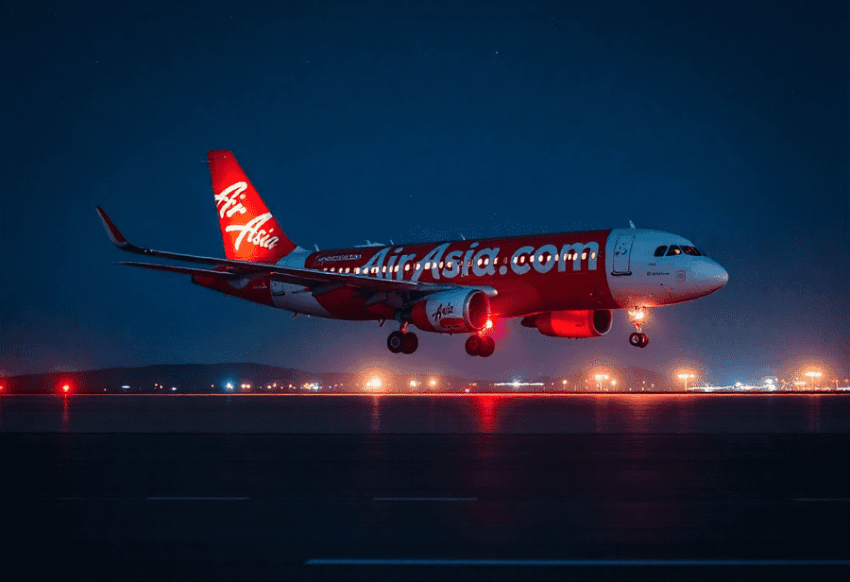Published on
August 16, 2025

A recent incident involving an AirAsia flight from South Korea has sparked widespread outrage and confusion after the plane was diverted to the wrong airport. Passengers were left stranded and frustrated as the airline’s failure to properly manage the situation led to chaos, highlighting serious concerns over operational protocols and safety. This error not only caused significant delays but also raised questions about the airline’s communication and handling of passenger needs during an unexpected diversion.
AirAsia, the Malaysia-based low-cost carrier, is currently facing a wave of criticism following a mishap involving one of its flights, which mistakenly landed at the wrong airport in South Korea. On the evening of August 14, Flight D7 506, which was initially set to land at Incheon International Airport, instead touched down at Gimpo International Airport, situated approximately 20 kilometers (12 miles) away. This error led to confusion among passengers, many of whom were unaware of the mix-up until after the plane had landed.
The flight had experienced delays prior to landing, as it circled over Korean airspace due to bad weather conditions. After several rounds in the air, the aircraft was cleared to land at its intended destination, Incheon. At the eleventh hour, the flight was redirected to Gimpo, where it touched down at 8:08 p.m. local time. This caused a ripple of confusion among the passengers on board, who had been expecting to arrive at Incheon.
What further compounded the situation was an announcement made by the captain upon landing. According to reports, the captain informed the passengers that they had arrived at Incheon, which led many to begin retrieving their personal belongings from the overhead compartments. It wasn’t until they glanced out of the windows or checked their phones that they realized they had actually landed at the wrong airport. The realization caused an immediate sense of disorientation and frustration among the passengers, especially since the announcement from the captain did not immediately clarify the situation.
As passengers disembarked and waited on the tarmac, the confusion continued. The airline staff did not make a clear announcement in Korean to explain the situation or offer any meaningful clarification. Instead, the passengers were left to wonder what had caused the error. Many passengers expressed dissatisfaction with the lack of communication from the airline during this period. Some stated that there was no formal apology or clear explanation regarding the situation, which further added to their anxiety and discomfort.
The miscommunication surrounding the arrival at the wrong airport continued as the plane remained grounded at Gimpo for nearly two hours. During this time, passengers grew more and more agitated, as there was no consistent information being relayed to them. Some passengers took to social media to express their frustration with the airline, noting that it was not the first time they had faced such issues with AirAsia. They complained that the airline had failed to manage the situation effectively, leaving them in a state of uncertainty and distress.
The delay, which lasted for two hours, was not the only problem. The failure of the crew to communicate effectively about the next steps or offer a timely apology further exacerbated the situation. Passengers on board reported that they were never fully informed about why the plane had been diverted to Gimpo in the first place, leaving many to speculate about the cause of the error. This lack of clarity and transparency led to a heightened sense of frustration among those on the flight.
Following a two-hour wait, the plane eventually left Gimpo at 10:03 p.m. and arrived at Incheon at 10:54 p.m. This marked the end of an already stressful journey for passengers, but the aftereffects of the confusion lingered. Once the plane had landed at Incheon, passengers were finally allowed to disembark, but many of them remained dissatisfied with how the situation had been handled by the airline.
Following the incident, AirAsia X released an official statement to explain the reasons behind the flight’s diversion to Gimpo. The airline explained that the decision to land at Gimpo was due to air traffic congestion at Incheon, which had been caused by adverse weather conditions. In the statement, the airline emphasized that the captain had followed standard procedures and had initially informed passengers about the diversion in English. However, the airline acknowledged that a miscommunication occurred during the cabin crew’s announcement after the plane had landed, which led to the confusion among passengers.
The airline assured the public that it was taking the matter seriously and would be reviewing its internal communication procedures to prevent similar incidents from occurring in the future. In response to the incident, AirAsia X revealed that it would be providing travel vouchers to passengers impacted by the diversion. The vouchers were intended as a goodwill gesture to make up for the inconvenience and confusion caused by the incident.
Despite the apology and the offer of travel vouchers, the incident has raised questions about AirAsia X’s communication protocols, especially in times of unexpected disruptions. For passengers, this incident highlights the importance of clear, timely communication, particularly during moments of uncertainty. The airline has committed to improving its procedures, but whether these changes will prevent future communication breakdowns remains to be seen.
An AirAsia flight from South Korea was mistakenly diverted to the wrong airport, causing chaos and anger among passengers due to the airline’s mishandling of the situation and lack of proper communication.
In the world of air travel, miscommunications like this one can often have far-reaching effects, and airlines must prioritize transparency and clarity when handling such situations. For AirAsia, this mishap serves as a reminder that even a minor mistake can have significant consequences on customer satisfaction and trust. It remains to be seen how the airline will rebuild its reputation after this costly error.





